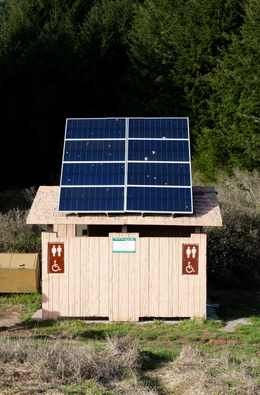Waste disposal has become one of the major problems in the modern era. The ever-growing population produces huge amounts of waste every day. Innovators and scientists are coming up with various efficient methods for the disposal of such waste, and the use of solar composting toilets is one of them.

Waste generated by humans can be hazardous to the environment, and composting toilets that use solar energy are an effective way of disposing human waste. This method of waste disposal, not only makes use of solar energy, but the end product can also be used as a very efficient fertilizer. This method uses fewer resources, especially very less amounts of water.
Working
A solar composting toilet occupies a lot of space, owing to the way that it is constructed. The processing unit that converts the waste into organic fertilizers, is located under the toilet. This unit is made up of an air staircase and a solar collector, that are placed adjacent to each other. The air staircase is inside the building, while the solar collector is situated outside. The organic waste that comes down from the toilet, is moved towards the end of the air staircase. During this time, the waste matter is subject to aerobic decomposition, which means that, the organic waste is simplified or decomposed in the presence of oxygen. The compost is stored in a separate chamber that is constructed at the end of the air staircase. During the storage period, the compost is aerated three times. The first time, it is aerated by the incoming heat from the solar collector. A PVC pipe is also used to put more air in the chamber, in order to further aerate the compost. The compost is aerated the third time, when air passes into the storage chamber and evaporates the moisture. This air circulation in the chamber boosts the decomposition process with the help of minimum water. A solar chimney is also attached to this chamber. The heat from the sun enhances the air circulation in the chamber and chimney, hence, a natural draft of air is created. This draft also gets rid of the odor emanating from the compost, completely. Organic substances that consist of a good amount of carbon, like saw dust or dead leaves, should be periodically added to the chamber, so that the air circulation in the pile of compost is maintained. According to the capacity of the toilet, the chamber is emptied from time to time, and the totally decomposed waste in the form of organic fertilizer is removed.
Advantages
The biggest advantage of solar decomposing toilets is that, they function with the help of heat from the sun. In short, resources like water, that are used for the decomposition of waste matter, are conserved. The volume of the composting chamber can also be varied according to the amount of waste matter that is disposed off every day. For example, big hotels can have huge compost chambers for this toilet system. The use of these toilets eventually saves a lot of resources. The most precious resource that can be conserved by the use of this technology is water. In normal waste treatment plants, huge volumes of clean and usable water are utilized to treat the waste matter.
The widespread use of such toilets will eventually save huge volumes of water. The best feature or merit of this technology is that, it can be used anywhere, i.e., it can be used in urban, rural, as well as suburban localities. Its widespread use will eventually result in sustained development and conservation of our environment.






 Waste generated by humans can be hazardous to the environment, and composting toilets that use solar energy are an effective way of disposing human waste. This method of waste disposal, not only makes use of solar energy, but the end product can also be used as a very efficient fertilizer. This method uses fewer resources, especially very less amounts of water.
Waste generated by humans can be hazardous to the environment, and composting toilets that use solar energy are an effective way of disposing human waste. This method of waste disposal, not only makes use of solar energy, but the end product can also be used as a very efficient fertilizer. This method uses fewer resources, especially very less amounts of water.